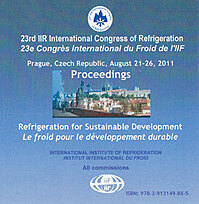
Document IIF
A propos d'une variante exergétique pas réellement utilisable dans l'analyse thermodynamique des systèmes à basse température.
On not really usable exergy variant at thermodynamical analysis of low-temperature systems.
Numéro : pap. ID: 161
Auteurs : ARKHAROV A.
Résumé
Historically, two approaches to analyzing high and low temperature systems have been formed in practical application: entropic and exergetic. They are of course different. Entropy is function of state, but exergy is not. It is clear that all notions should be adequate in a united thermodynamic temperature space for all temperatures both low and high ones. From this point of view the notion of working efficiency of heat (exergy) should be defined also in the low temperature field for “decreased” heat, i.e. for heat passing from the body at higher temperature to the body at lower one. If we adopt this initial position then so called well known exergetic curve is not correct as it is relative to heat that may be taken by the flow. In the field of low temperatures the notion of exergy should be related to heat source, for example medium, that may accomplish the work when a cold receptor is available. In that case the curve of exergy is a straight line in the field of low temperatures. The author was satisfied that an entropic-statistical method is more rational to analyzing low temperature systems.
Documents disponibles
Format PDF
Pages : 5 p.
Disponible
Prix public
20 €
Prix membre*
Gratuit
* meilleur tarif applicable selon le type d'adhésion (voir le détail des avantages des adhésions individuelles et collectives)
Détails
- Titre original : On not really usable exergy variant at thermodynamical analysis of low-temperature systems.
- Identifiant de la fiche : 30001585
- Langues : Anglais
- Source : Proceedings of the 23rd IIR International Congress of Refrigeration: Prague, Czech Republic, August 21-26, 2011. Overarching theme: Refrigeration for Sustainable Development.
- Date d'édition : 21/08/2011
Liens
Voir d'autres communications du même compte rendu (569)
Voir le compte rendu de la conférence
Indexation
-
Desirable thermophysical properties of fluids i...
- Auteurs : BORSUKIEWICZ-GOZDUR A., NOWAK W.
- Date : 02/08/2005
- Langues : Anglais
- Source : Commercial Refrigeration. Thermophysical Properties and Transfer Processes of Refrigerants. Proceedings of the IIR International Conferences.
- Formats : PDF
Voir la fiche
-
Une présentation exergétique unitaire des diver...
- Auteurs : LE GOFF P., HORNUT J. M.
- Date : 06/07/1998
- Langues : Français
- Source : Thermodynamics, heat and mass transfer of refrigeration machines and heat pumps. Proceedings of the EUROTHERM Seminar 59./ Thermodynamique et transferts de chaleur et de masse dans les machines à froid et pompes à chaleur. Comptes rendus du séminaire EUROTHERM 59.
Voir la fiche
-
CONTENU THERMODYNAMIQUE DES FACTEURS D'INTEGRAT...
- Auteurs : SEDLAK J.
- Date : 24/08/1987
- Langues : Français
- Source : Development in refrigeration, refrigeration for development. Proceedings of the XVIIth international Congress of Refrigeration.
- Formats : PDF
Voir la fiche
-
Relationships between irreversibility (exergy d...
- Auteurs : KRAKOW K. I.
- Date : 1994
- Langues : Anglais
- Source : ASHRAE Transactions 1994.
Voir la fiche
-
About a more intuitive exergy efficiency calcul...
- Auteurs : STAICOVICI M. D. N.
- Date : 18/06/2018
- Langues : Anglais
- Source : 13th IIR Gustav Lorentzen Conference on Natural Refrigerants (GL2018). Proceedings. Valencia, Spain, June 18-20th 2018.
- Formats : PDF
Voir la fiche
